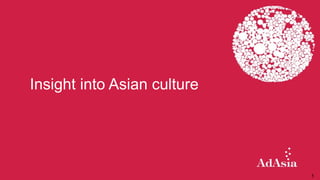
AdAsia_Insight to Asian Culture
- 1. 1 Insight into Asian culture
- 2. 2 Why Culture Matters Culture consists of the characteristics defined by language, religion, customs, social habits, music, and the arts. In marketing, culture is the DNA that identifies how the target demographic thinks, speaks, and acts.
- 3. 3 Fusion Diversity Diversification Assimilation Interaction Need to Fit In Need to Stand Out Culture Changes Overtime Human interaction impacts cultural changes.
- 4. 4 Cultural System Cultural differences manifest through symbols, heroes, rituals, and values. Values are the core of one’s mental map that drive cultural behavior. Source: Hofstede Dimensions Symbols: Visual/verbal icons Heroes: Role Models Rituals: Collective Activities Values: Belief System Evil vs. Good Decent vs. Indecent Forbidden vs. Permitted Natural vs. Unnatural Normal vs, Abnormal Irrational vs. Rational Ugly vs. Beautiful
- 5. 5 Cultural Dimensions According to Hofstede, cultural differences can be measured in 5 different bipolar dimensions. Large/Small Power Distance Uncertainty Avoidance Individualism - Collectivism Masculinity - Femininity Long Term - Short Term 0 20 40 60 80 100 120 Large/Small Power Distance Strong/Weak Uncertainty Avoidance Individualism/ Collectivism Masculinity/ Femininity Long/Short term Orientation China Korean USA Mexico Source: Hofstede Dimensions China Korean Japan Vietnam India Philippines USA Mexico Large/Small Power Distance 80 60 54 70 77 94 40 81 Strong/Weak Uncertainty Avoidance 30 85 92 30 40 44 46 82 Individualism/ Collectivism 20 18 46 20 48 32 91 30 Masculinity/ Femininity 66 39 95 40 56 64 62 69 Long/Short term Orientation 118 75 80 80 61 19 29 29
- 6. 6 Asians accept that power is distributed unequally. Thus, a relationship is based on hierarchy instead of equality; power is often determined by birth, caste, family status, or profession. In modern society, power is largely defined by economic power and is prominently displayed through personal possessions in the form of multiple luxury homes, cars and designer items. (Fact: 25% of traffic to luxury brand websites is generated by Asian Americans) Large Power Distance
- 7. 7 Personal identity is based on the social networks Asians belong to Thus, personal opinions are heavily influenced by groupthink. Asians’ lives are often pervaded by family/friend groups and their success is attributed to their team/network instead of individual achievement. Their community/social circle is their primary source of information and influences all decision-making. (Fact: Asian American users over-index on many social media platforms. 3 out of 4 use social media.) . Collectivism
- 8. 8 Femininity Masculinity The assertive pole has been called, ‘masculine’ and the caring pole, ‘feminine’. Femininity stresses the importance of equality, solidarity, and quality of work life; the focus is on people and emotion. (Warm , Caring, Emotional, Down to Earth, Spiritual, Social) Masculinity stresses the importance of impartiality, competition among colleagues, and performance; the focus is on performance and progress. (Fun, Humorous, Confident, Factual, Logical, Exaggerated, Dignified) Korean and Vietnamese cultures are considered more feminine, and the Japanese and Chinese cultures, more masculine.
- 9. 9 Uncertainty Avoidance UA—the degree to which people express emotion or anxiety outwardly. In Asian culture, public displays of personal thoughts and feelings are quite minimal; expressions are typically modest and controlled. However, although public insobriety is viewed as shameful, Asians are unafraid to outwardly express their feelings while drinking. In fact, it is one of the few instances wherein expressing emotion is expected. The Koreans and Japanese are less likely to openly express their emotions compared to the Chinese, Vietnamese, Filipino, and Asian Indian.
- 10. 10 Asians focus on virtue, hope, endurance, sacrifice, and vision. Asians are driven by optimism. They prioritize long-term, financial investment planning and the future of their children. Long Term Orientation
- 11. Thank You Michael Hong | Director of New Business Development AdAsia Communications, Inc. 400 Sylvan Avenue, Englewood Cliffs, NJ 07632 P: 201.608. 0388 ext. 133|F: 201. 608.0560 www.adasia-us.com
